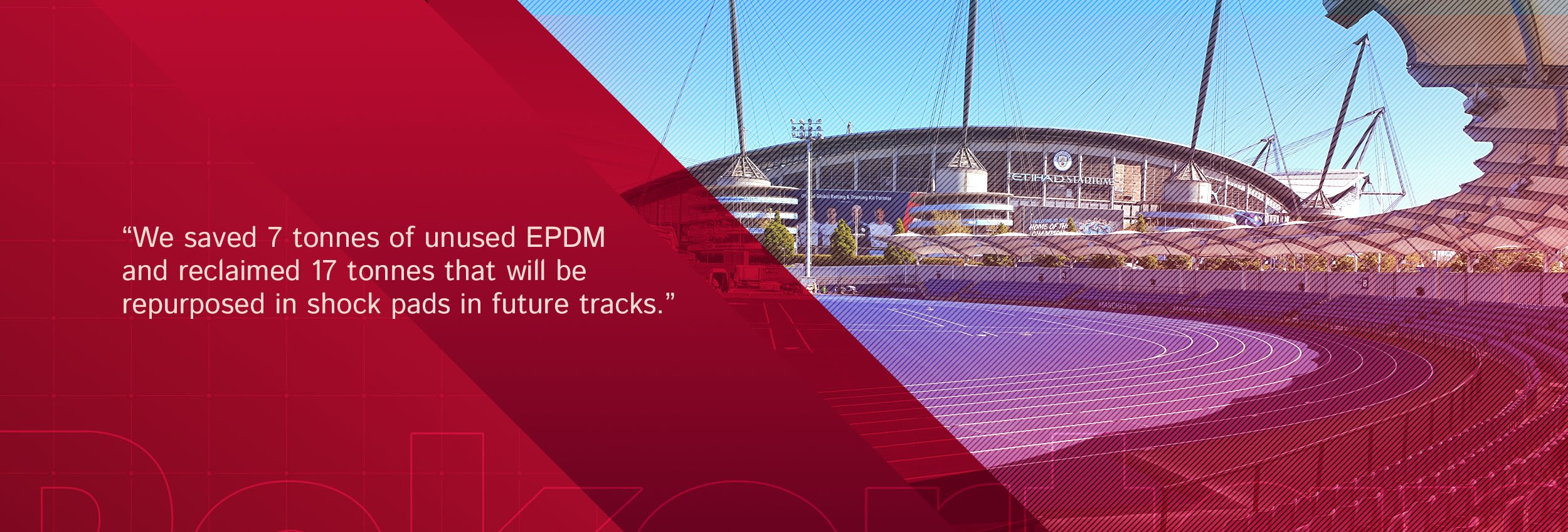Run Green. Run on Gel.
Athletics is on track to become greener.
World Athletics has set the goal to become carbon neutral by 2030 as part of a 10-year Sustainability Strategy. Clubs, schools and communities around the world are following suit and increasingly seeking greener options for their athletics spaces.
At Rekortan, we are committed to protecting the future of the sport we love through the use of green technology, renewable resources and energy-efficient production practices.
Rekortan Gel Tracks are the world’s greenest tracks.
Our Rekortan Gel Series is the result of 50+ years of R&D designed to create the most environmentally-friendly running tracks on the planet. Incorporating plant-based oils, the gel layer is made with 84% renewable and recyclable content and is manufactured using an enzyme process which requires minimal electricity consumption.
Built to last. Not for landfill.
Longevity is good for the environment and we have ensured our Gel Tracks retain over 95% of their force reduction over 10 years. This gives them an environmental and performance lifespan that outruns traditional track systems that can go hard quickly. Designed to withstand UV degradation even in the harshest of climates, and to resist water damage through a hydrophobic formulation that repels water, our Gel Tracks reduce stress on the environment and the athlete.
The Science of Track Longevity
Why the best tracks will run, and run, and run.
The key to increasing a track’s lifespan is determined in its first few days. The initial construction needs to be meticulously carried out by experienced teams using high-quality substrates (asphalt and concrete) and a proven track system laid on top.
Rekortan Track systems have been built with durability at their core. Composed of high-quality materials and designed as an integrated system of components, they are also optimized to withstand UV and water degradation so that the top layer doesn’t wear out or lose its color over time.
Tracks that look and feel good, attract runners time and again
The technology and materials in Rekortan tracks help them to retain a mix of force reduction, energy return and provide the balance required for training and race-day performance over time. Conversely, some tracks go hard comparatively quickly making them uncomfortable to run on. This makes them unfit for training and off-putting to social runners leaving your track in danger of sitting idle most of the time.
Maintenance for use again and again
Like most things, running tracks are not impervious to external forces. They benefit from regular maintenance, including washing with high pressure jets, capturing loose crumb and cleaning the gullies and filters which can become blocked by leaves and grass causing water-retention and algae build-up.
Track repairs are also common and important, especially in high-use areas such as the inside lane, the 100m start and the throwing and jumping take-off areas.
Re-topping can increase your track’s lifespan to 30 years
Re-topping a good track system will extend the lifecycle before replacement materials, which have an environmental and financial impact, are required.
Rekortan tracks are successfully re-topped around the world.
Both the Manchester Arena and Alexander Stadium in the UK have been re-topped to Diamond League standard, doubling their lifespan.
The Newport Stadium in Wales is on its third re-top and is on track to last 30 years, whilst the Kerryn McCann Athletics track in Australia was re-topped in 2017 which will take its lifespan beyond 30 years.
How Rekortan is Reclaiming Rubber and Reducing Microplastics
Track Responsibly
Rubber is a key component of modern running tracks, giving them better force reduction and energy return compared to their grass, cinder and sand predecessors. Yet while today’s tracks reduce stress on the athlete’s body, the introduction of rubber provides an environmental stress factor that the sport surface industry has a responsibility to minimize.
Saving rubber and limiting microplastics is a top priority for Rekortan, and with over 50 years of experience, we know how to install tracks responsibly.
Almost half of the rubber we use is reclaimed
For the top layer of our tracks, we allow 4.2 kgs of EPDM rubber per square meter and with best practice, we aim to reclaim up to 2 kgs per square meter. This means up to 45% of the rubber is reclaimed.
24 tonnes saved at the Manchester Arena (UK)
At the recent installation of a Polytan/Rekortan M track at the Manchester Arena in the UK, we were able to recycle or repurpose 24 tonnes of EPDM. This was achieved by laying plastic catch sheets during the topcoat installation. The sheets captured EPDM rubber granules, which were reused as we progressed.
Repurposing and Recycling Rubber to transform sport and spaces
Reclaimed rubber is also repurposed in shock pads for future tracks. Due to its excellent durability, it has significant benefits as paving for high stress areas, such as the 100m start and the jumping and throwing areas. We also recycle it into e-layers for synthetic grass facilities, into playground and landscaping surfaces and golf course pathways.



